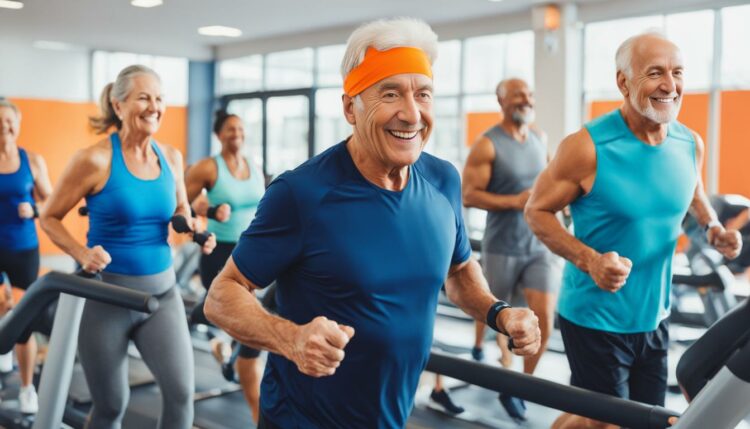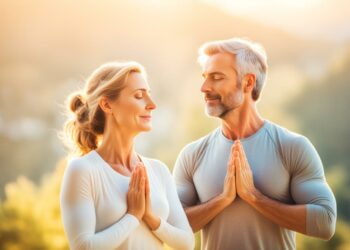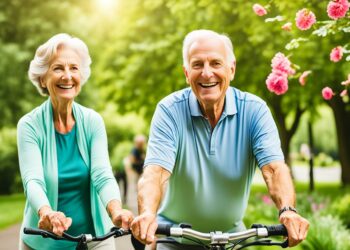Aging is a natural process that affects everyone differently. The key to healthy aging lies in taking care of our bodies, minds, and spirits. One crucial aspect of this is regular exercise. Engaging in physical activity not only promotes well-being and vitality but also has numerous benefits for older adults.
When it comes to exercise for healthy aging, the focus should be on staying active and maintaining an active lifestyle. Incorporating physical activity into your daily routine, such as gardening or taking regular walks, can significantly improve your overall quality of life.
The key is to find activities that you enjoy and that suit your fitness level.
Regular exercise has been shown to reduce stress levels, boost energy, and reduce the risk of chronic health conditions. It also has a positive impact on mental health, improving mood and reducing the risk of mental disorders.
Additionally, exercise plays a role in promoting better sleep quality, which is vital for overall well-being.
Key Takeaways:
- Regular exercise is essential for healthy aging.
- Engaging in physical activity reduces the risk of chronic diseases.
- Exercise improves mental health and reduces stress levels.
- Incorporating exercise into your daily routine enhances overall well-being.
- Finding activities you enjoy and setting realistic goals is key to maintaining a regular exercise routine.
Importance of Exercise for Healthy Aging
Regular exercise is a crucial component of promoting healthy aging. Engaging in physical activity has numerous benefits, including enhancing longevity, improving fitness in seniors, and maintaining an active lifestyle as you age.
Research suggests that adults aged 40 and older who take 8,000 steps or more per day have a 51% lower risk of death from all causes.1
Exercise plays a pivotal role in reducing the risk of chronic diseases such as cardiovascular disease, diabetes, and obesity. By incorporating physical activity into your daily routine, you can improve your overall well-being and quality of life.
Regular exercise also has positive effects on mental health, as it boosts mood, increases energy levels, and reduces the risk of mental disorders such as anxiety, depression, and cognitive decline.
“Exercise is the key to staying youthful and vibrant as you age. It not only helps to maintain physical health but also enhances mental well-being, which is essential for leading a fulfilling and enjoyable life.” – Dr. Michelle Thompson, Senior Fitness Specialist
Physical activity is a powerful tool for healthy aging, contributing to increased longevity and improved overall health. By staying active as you age, you can experience the transformative benefits of exercise firsthand.
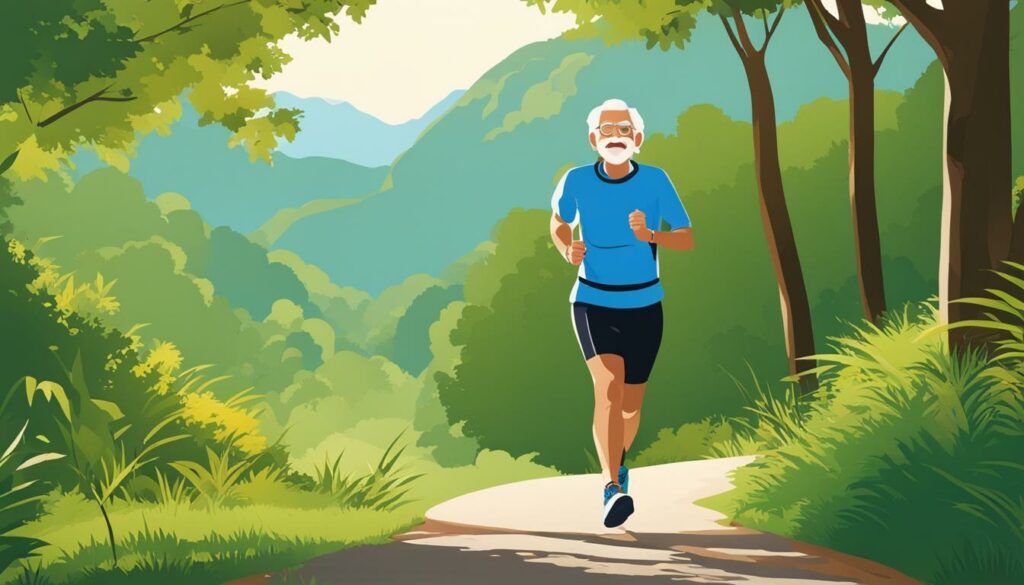
Next, we will explore some practical tips for incorporating exercise into your daily routine to ensure a healthy and active lifestyle as you age.
References:
- Walking and mortality in sedentary older adults: A systematic review and meta-analysis of 11 cohort studies. Cheval B, et al. Scandinavian Journal of Medicine & Science in Sports, 2020.
Tips for Incorporating Exercise into Your Routine
If you’re looking to improve your senior fitness level, incorporating exercise into your daily routine is key. Starting a new workout routine can be daunting, but with the right approach, it can become a manageable and enjoyable part of your life. Here are some fitness tips for seniors to help you get started:
- Dedicate a few minutes each day: Begin by dedicating just a few minutes each day to physical activity. Whether it’s brisk walking, stretching exercises, or light strength training, these small efforts can go a long way in building endurance and stamina.
- Consistency is key: Over time, aim to increase the duration and intensity of your exercises. Regular exercise will not only increase your energy levels but also improve your overall productivity and well-being.
- Choose activities you enjoy: Find physical activities that you enjoy and look forward to. This could be anything from walking in nature, gardening, swimming, or practicing yoga. When you enjoy the activity, you’re more likely to stick with it in the long run.
- Wear appropriate gear: To optimize your performance and enhance your overall exercise experience, make sure to wear appropriate gear. This could include comfortable and supportive shoes, breathable clothing, and any necessary protective equipment.
- Exercise without breaking the bank: Incorporating exercise into your routine doesn’t have to be expensive. There are plenty of budget-friendly options such as walking in your neighborhood, utilizing free community fitness classes, or following online workout videos.
- Set realistic goals: Set realistic goals that align with your fitness level and abilities. Start with small milestones and gradually increase the intensity and duration of your workouts. Remember, consistency is more important than pushing yourself too hard too soon.
By making senior fitness a priority and following these fitness tips for seniors, you can successfully incorporate regular physical activity into your life. Remember to consult with your doctor before starting any new exercise program, especially if you have any pre-existing health conditions. Overall, the key is to find an exercise routine that you enjoy, stick with it, and reap the numerous benefits it provides for your physical and mental well-being.
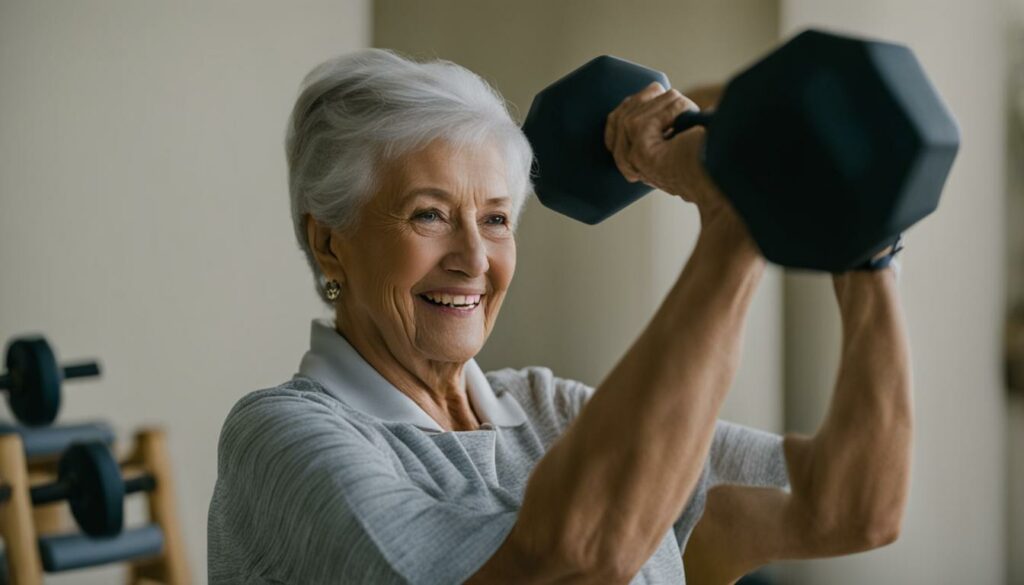
Best Types of Exercise for Healthy Aging
The ideal exercise routine for healthy aging encompasses a combination of aerobic exercise, strength/resistance training, and flexibility exercises. By incorporating these different types of exercise into your fitness regimen, you can enhance your overall well-being and promote graceful aging.
Aerobic Exercise:
Aerobic exercise, also known as cardio, is essential for maintaining cardiovascular health and endurance. It involves activities that increase your heart rate and breathing, such as walking, swimming, cycling, or dancing. Regular aerobic exercise improves circulation, boosts energy levels, and reduces the risk of heart disease, diabetes, and obesity.
Strength/Resistance Training:
Strength training is crucial for preserving muscle mass and bone density, which naturally decline with age. It involves using resistance, such as weights or resistance bands, to challenge your muscles.
Engaging in strength training exercises, like squats, lunges, push-ups, or lifting weights, helps build strength, coordination, and balance. It also reduces the risk of age-related muscle loss and osteoporosis.
Flexibility Exercises:
Flexibility exercises focus on stretching and improving the range of motion in your joints. These exercises help maintain flexibility, prevent stiffness, and reduce the risk of falls.
Popular flexibility exercises for older adults include yoga, tai chi, Pilates, or simple stretching routines. These activities not only enhance physical flexibility but also promote mental relaxation and stress reduction.
Remember to choose activities that you enjoy and that align with your fitness level and abilities. Incorporate a variety of exercises into your routine to target different muscle groups and aspects of fitness.
By engaging in a well-rounded exercise routine that includes aerobic exercise, strength/resistance training, and flexibility exercises, you can promote healthy aging and enjoy an active and fulfilling life.
Conclusion
Regular exercise plays a vital role in healthy aging, offering numerous benefits for older adults. By incorporating physical activity into your daily routine, you can reduce the risk of chronic diseases, enhance mental well-being, and boost energy levels.
Starting slowly and gradually increasing your exercise routine is essential. It’s also important to consult with your doctor before starting any new exercise program, especially if you have any health conditions.
Exercise is a prescription for life, and it’s never too late to start reaping its benefits. Aging gracefully is possible by prioritizing fitness and making regular physical activity a part of your healthy aging journey.
FAQ
Why is regular exercise important for healthy aging?
Regular exercise is important for healthy aging because it reduces the risk of chronic diseases, improves mental well-being, and boosts energy levels.
What are the benefits of exercise for older adults?
Exercise for older adults has numerous benefits, including reducing the risk of chronic diseases, improving mental health, and increasing longevity.
How can I incorporate exercise into my daily routine as I age?
You can incorporate exercise into your daily routine by dedicating a few minutes each day to physical activity, choosing activities that you enjoy, and setting realistic goals.
What types of exercise are best for healthy aging?
The ideal exercise routine for healthy aging should include a mix of aerobic exercise, strength training, and flexibility exercises.
Is it ever too late to start exercising for healthy aging?
It is never too late to start exercising for healthy aging. Starting slowly and gradually increasing your exercise routine can help you reap the benefits at any age.
